Longtime Zephyr readers won’t need any introduction to Herb Ringer. His photography has appeared in this publication for nearly our entire existence. As a photographer, and a chronicler of the 20th century, he has always been right at the heart of the Zephyr.
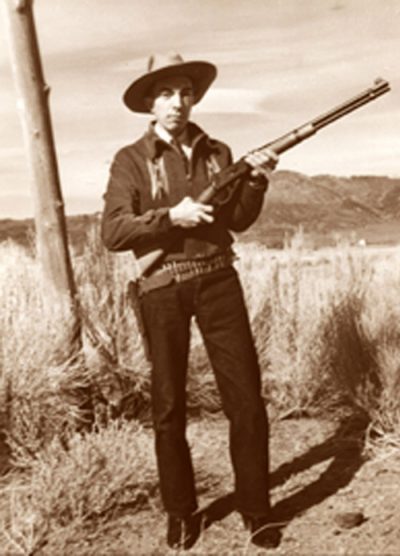
Herb was an Easterner, born in Brooklyn in 1913, who became the most dedicated kind of Westerner. He came to Reno, Nevada to obtain a divorce in 1939, and his immediate appreciation for “the Western Life,” as he called it, drew him to settle there. He brought his parents from their home in New Jersey to live with him in the early 40s. And the family set out constantly on road trips, driving through the surrounding country, camping out in a succession of prized traveling vehicles, and discovering all the endless variety of the West. Herb dedicated himself to documenting, with photos and meticulous notes, all the details of his newfound home.
Over the course of the next fifty years, Herb compiled one of the country’s greatest archives of the changing West. He saved everything. And, when he couldn’t travel any longer, he gave the gift of his archives to Jim. We’ve been exploring his notes and photos, and sharing them with readers ever since.
Recently, we set off on a few of Herb Ringer’s trips ourselves, wanting to see how the landscape of Herb’s western world has changed over the last 80 years.
This past fall, we visited Death Valley, one of the Ringer family’s favorite weekend escapes. We sought out some of our favorite locations from Herb’s photos, and discovered what was the same, and what was noticeably different after all this time.
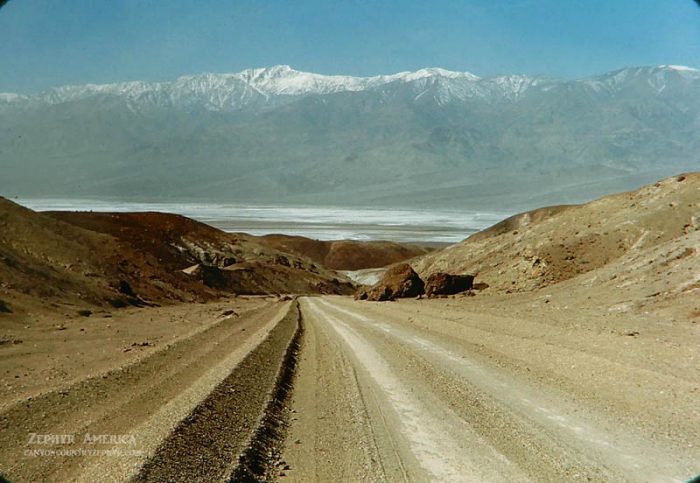
** ** **
Panamint Springs
When Herb and his parents visited Death Valley, they almost always came from the East. His father Joseph Ringer’s journal entry from New Years Eve of 1947/48 provided their typical route:
New Years Eve. I took off at the Mill Company and Herb at the store and we left Reno at 6:15pm. Went to Hawthorne Nev. and stopped for gas. Went on to Tonopah Nev, and stopped for gas and then stopped at Beatty for gas and got down to Death Valley Calif by 2am New Years Day Jan 1st, 1948, so this is our first camp out in the new year…
We, on the other hand, were coming from the West. We set off from our motel room in Lone Pine, CA early on a late October morning. We drove into the western edge of the National Park and stopped at Panamint Springs, knowing that we were trailing Herb’s trips in reverse. We parked and walked up to the Panamint Springs Resort.
Herb took this exterior shot in 1950…
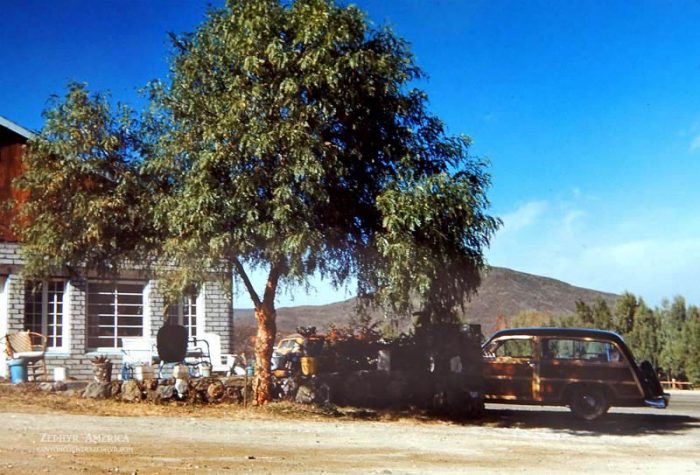
In 2020, the spot Herb knew as the “Panamint Springs Lodge” was clearly grappling with different realities. A large tented dining area had been constructed outside for pandemic-style dining.
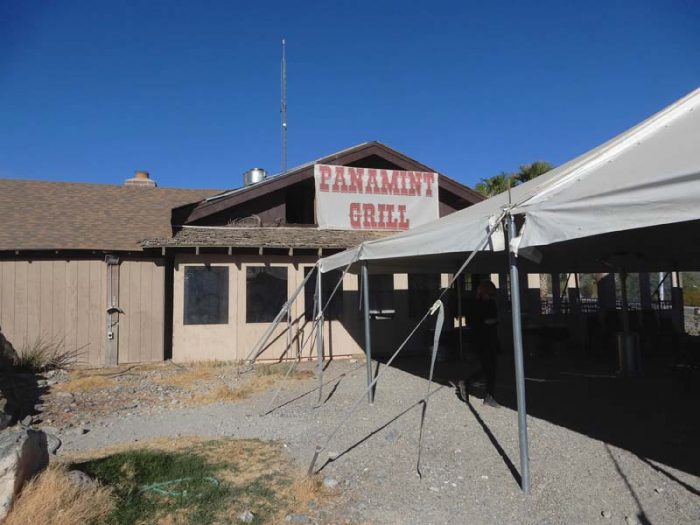
Still, behind the wide roofed patio area, the contours of the original building remained the same.
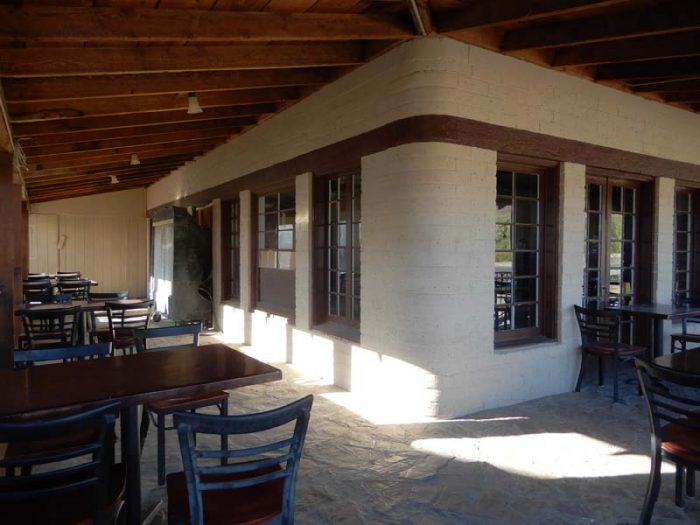
In 1947, Herb and his parents stopped in for lunch at the Lodge, and Herb took this interior shot. He noted on the slide that his father had played the piano while they relaxed…
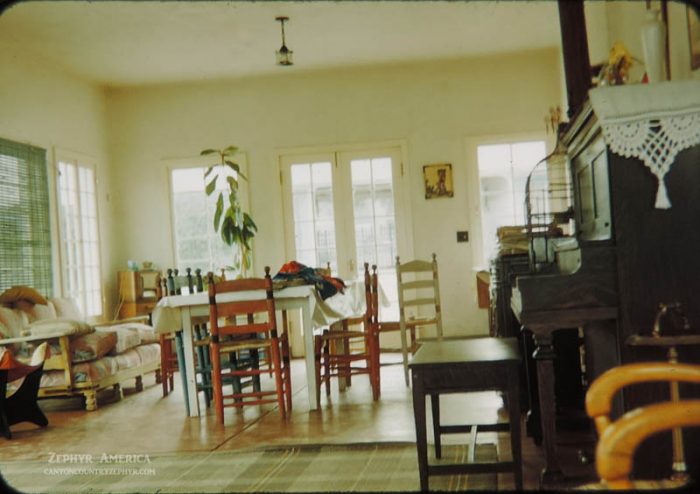
We arrived at Panamint too early for the lodge/resort to be open, and we weren’t sure it would open at all, given the realities of the year. We were able to peek into one of the windows and see that the french doors looked the same. It was impossible at that time of day to get a decent shot through the window, but it looked like an interior wall had been removed at some point.
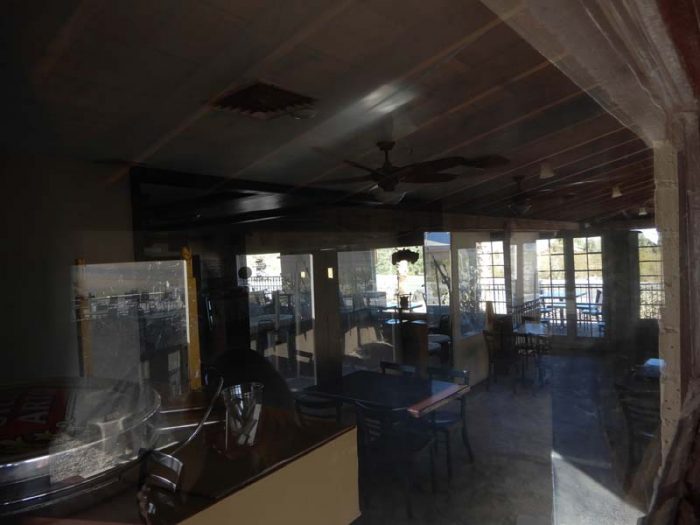
Behind that building was a line of cabins. Herb took this shot in 1947…
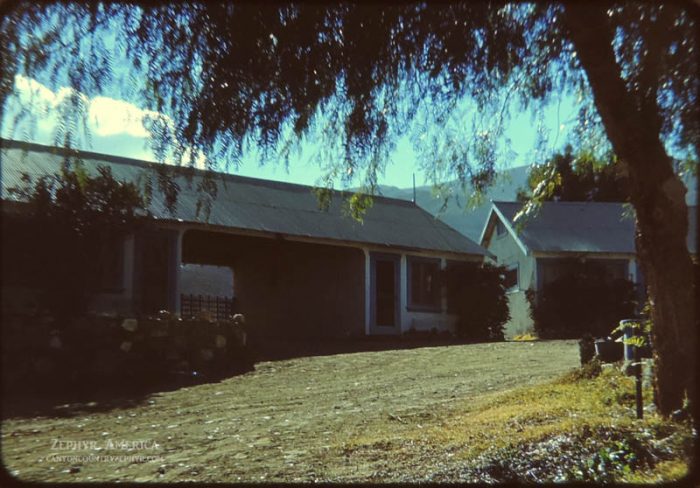
And, in 2020, they were still there. The gaps between them had been filled at some point, and the general décor was more rustic now than it was in the 40s, but the structure was clearly recognizable…
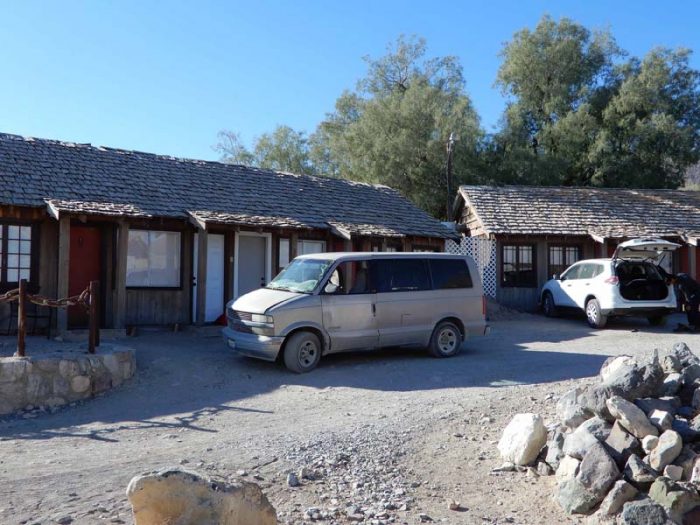
When Herb knew the area, Panamint Springs was outside the boundaries of the Death Valley National Monument. Joseph mentions the Panamint Range in his journal for the first time on that same New Year’s trip, noting that the mountains they’d crossed as they left Death Valley to the west had that name.
The Western Entrance
Herb took this photo of the entrance station at the western boundary of the Monument in 1947.
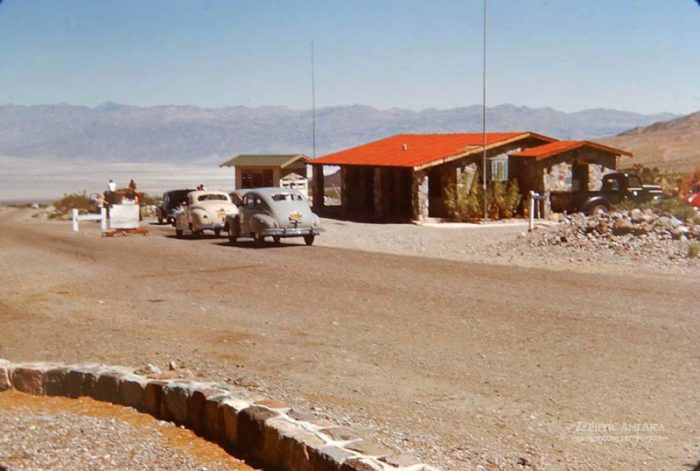
In 2020, the building was still there, just past the Emigrant campground. No one is required to stop there anymore and the spot felt quiet. The only reason to pause was a small restroom and water well across the road, which one woman was using to perform some rudimentary clothes-washing while we walked around.
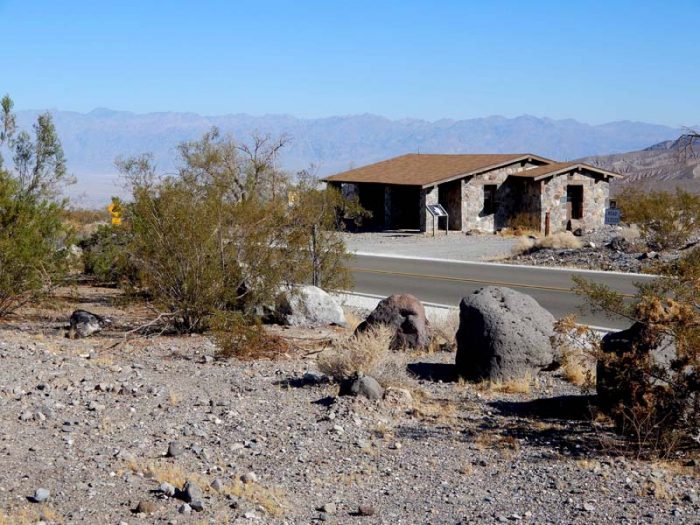
Stovepipe Wells
We arrived at Stovepipe Wells mid-morning. The stream of normal tourist traffic had begun to reach the hotspots of the park. Before then, the drive had been so quiet and the road so empty, we had almost been able to fool ourselves that we were visiting in Herb’s era.
We don’t have a date for this photo Herb shot of the hotel at Stovepipe Wells, but it was almost certainly in the late 40s. He noted on the slide that the hotel and concessions were owned by a man named Putnam in those days, a famed author and also the husband of Amelia Earhart. Putnam died in 1950, so it’s likely the photo predates that year…
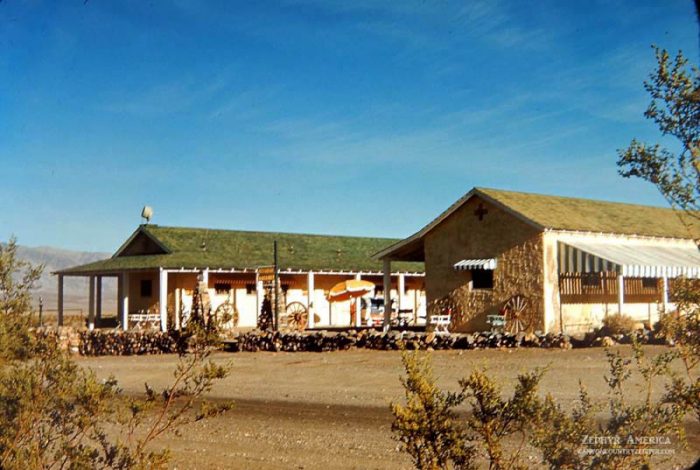
In 2020, the buildings are clearly the same, though their architecture has been rusticized over the years to fit the modern Park Service style.
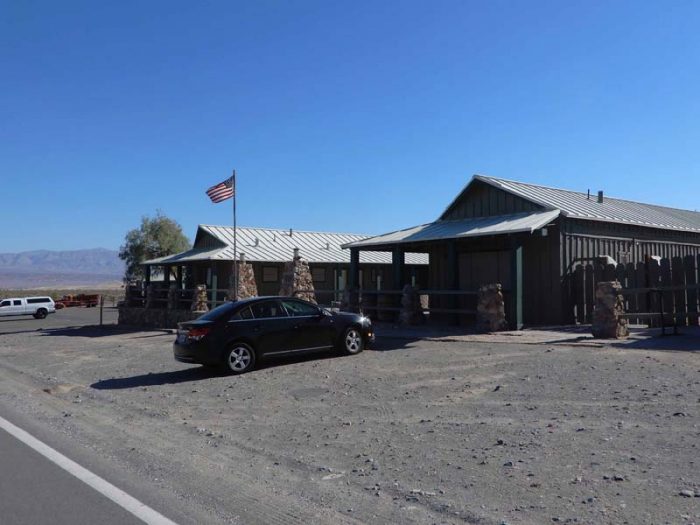
Turned off by the constant flow of traffic through the convenience store across the street, we got back into our car and continued into the heart of the Park.
** ** **
To drive into Death Valley, in any year, is a moving experience. It’s difficult to describe the sheer contrast in colors, and the seeming impossibility of the landscape around you. On his trips to Death Valley, Herb carried with him the 1939 WPA Guide to the Monument, which he had purchased at Compton’s Booksellers in Reno. It begins with these lines:
Ever since the first immigrants saw Death Valley, fantastic tales have been told of its blasting temperatures and stupendous riches, but exaggeration is inevitable in describing this narrow valley of strange, exciting beauty, cradled between towering, varicolored mountains.
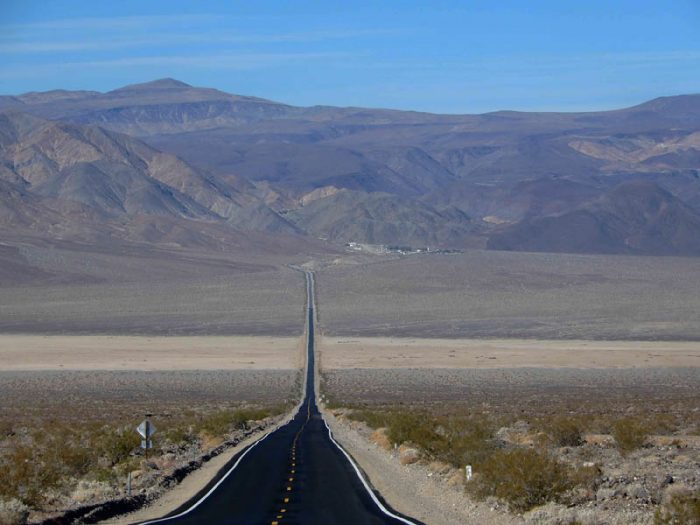
When that guide was published, the Valley had only been a monument for six years. Before 1933, it notes: “Death Valley was largely cared for by the Pacific Coast Borax Company which still conducts the hotels, camps, service stations, and other facilities at Death Valley Junction and Furnace Creek Inn.”
When Herb first visited, in 1942, the Monument wasn’t even ten years old. There were still active mines in the Panamints, “many of them owned and worked by men who knew the feverish days of Rhyolite, Skidoo, Ballarat, and Darwin. These men,” as the WPA Guide describes them, “are brown and lean–for desert heat does not encourage accumulation of fat; and they are friendly to those who love their barren, mysterious desert.”
Texas Springs
The Ringers often arrived in Death Valley very late at night, having left Reno at six or seven in the evening, when their work was finished for the day. Joseph sometimes referenced sleeping in their car near the “Borax place,” which was probably the Harmony Borax Works. But when they arrived early enough, and were settling in for a longer stay, they preferred to camp at Texas Springs. Herb took this shot of their campsite in the early 50s.
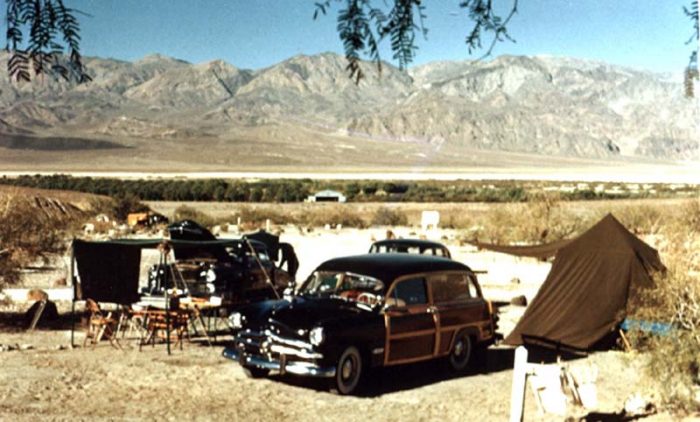
In the background of Herb’s shot is the hangar of the long-lost Death Valley Airport. Built in the 20s by the Pacific Coast Borax Company, the airport was maintained by the Park Service in the early years of Herb’s visits. During the war, both the Army and Navy had used the airport as a landing field. It was closed in 1953, as another paved airstrip was built across the highway, and the hangar was demolished. Now the space is used for overflow parking. Here’s the same view in 2020…
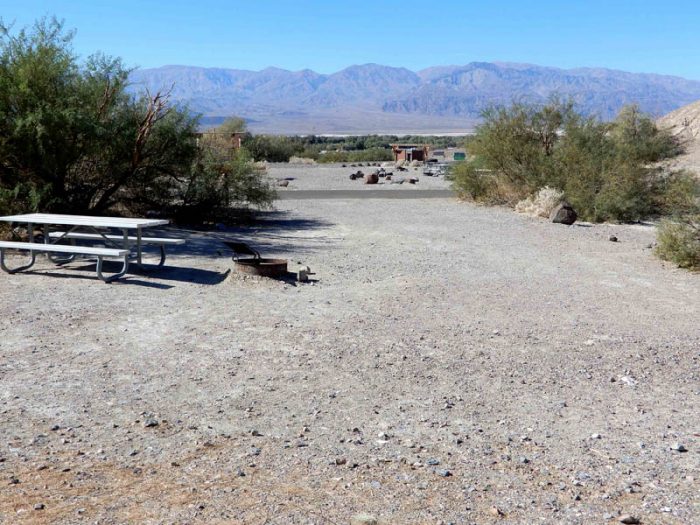
Herb took more photos of Texas Springs in the late 50s. The Family’s Ford truck features prominently in the shots..
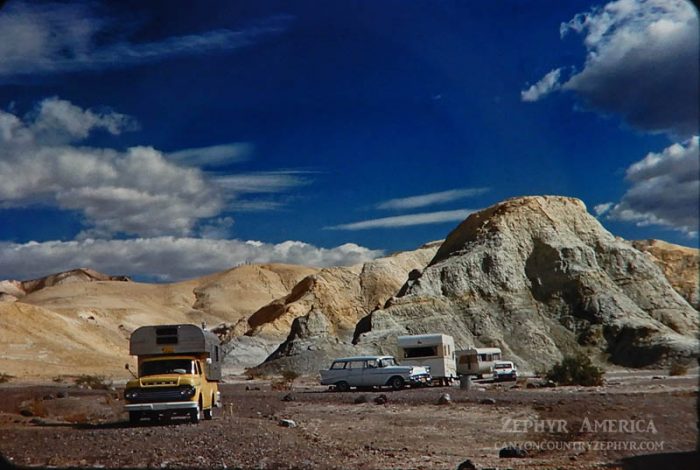
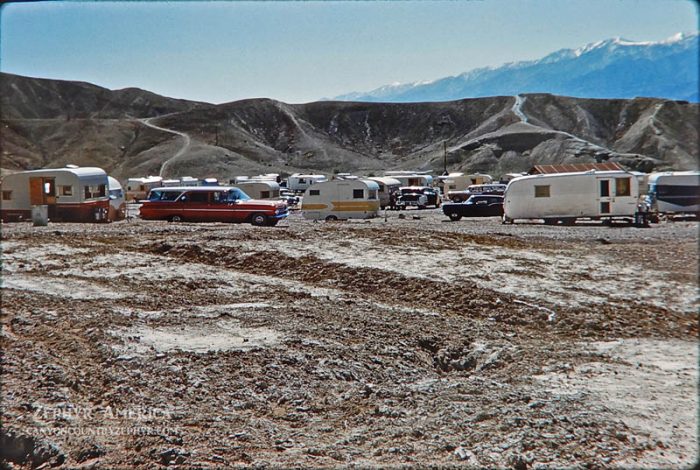
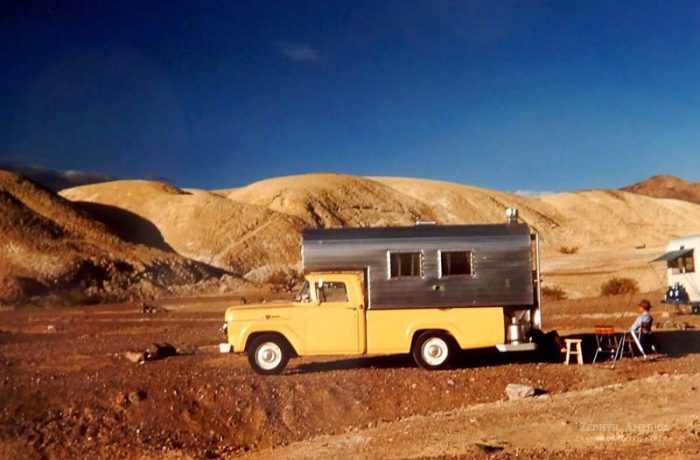
While the style of the campers has changed drastically over the years, the campground still looks essentially the same in 2020…
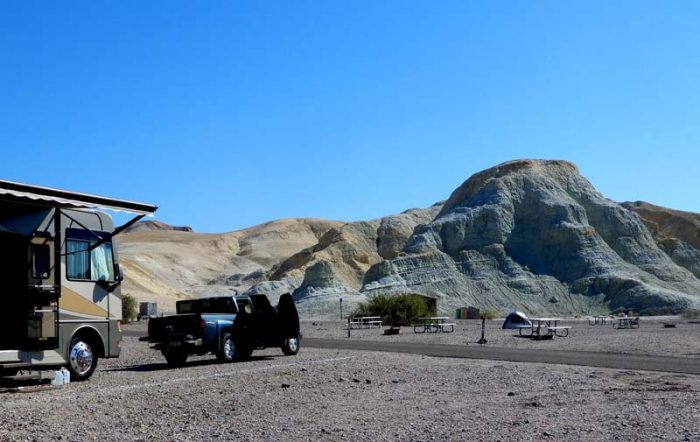
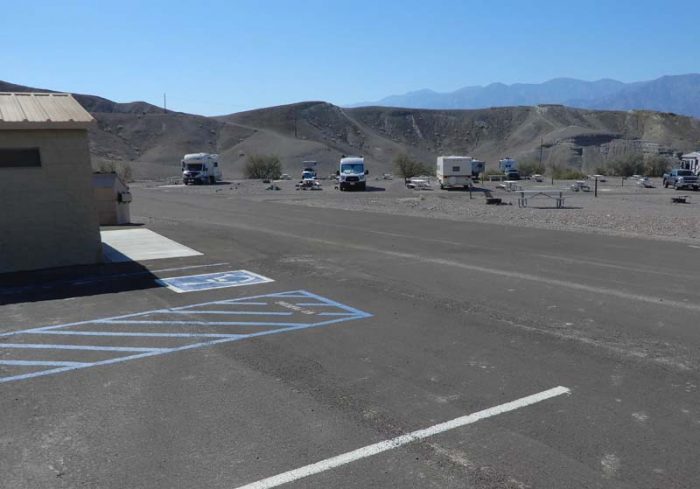
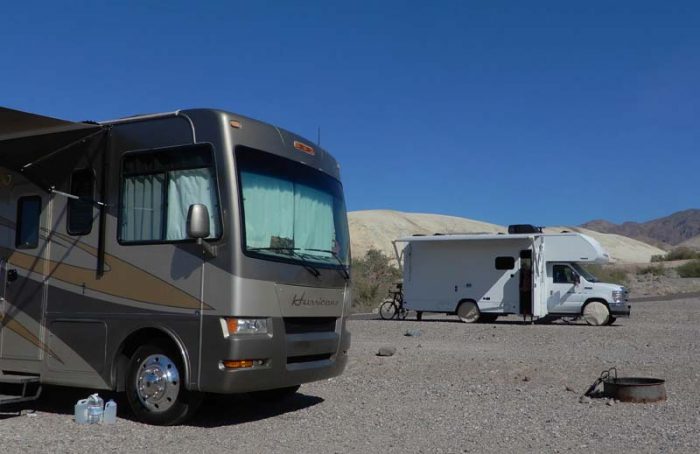
As we were shuffling back and forth, trying to line up these shots, we ended up meeting the owners of some of the RV’s in the campground. They were… well, a little concerned about us taking pictures at first. As soon as we showed them Herb’s original shots, though, and pointed out the recognizable background, they became enthusiastic. They called over their friends from another campsite to see the photos. One woman looked down at the photos, then up again at her own RV and said, “Huh. I guess camping sure has changed since then, hasn’t it?”
The Furnace Creek Inn
The Ringer family liked the proximity of the Texas Springs campground to the Inn at Furnace Creek. While they couldn’t afford to stay there, Joseph wrote in March of 1947 how they “spent the rest of Palm Sunday at Furnace Creek Calif. Took lots of pictures of the big hotel. It was the 1st time we walked inside of the hotel and visited their beautiful gardens and grounds all around.”
Herb took this photo of his parents in the hotel grounds in 1948.
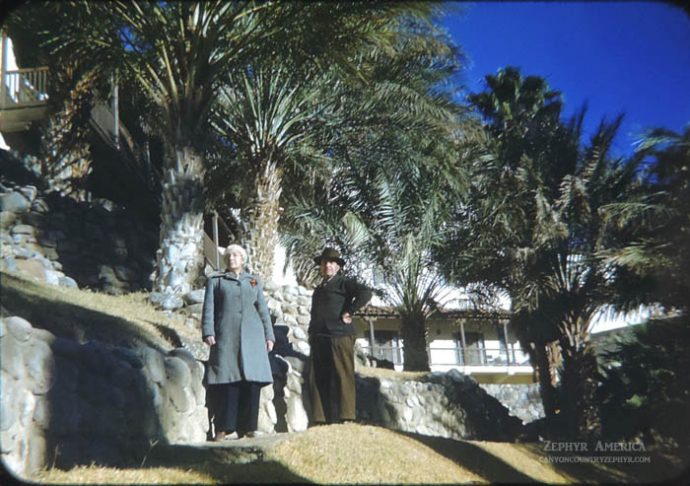
And he took this photo outside the hotel in the same year…
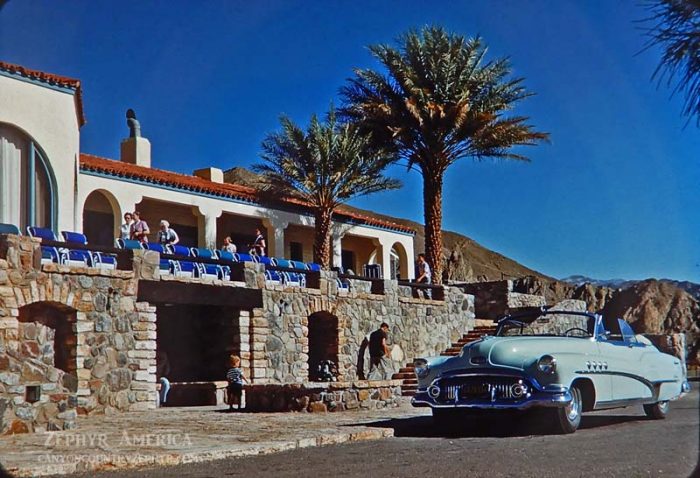
Like the Ringers, we weren’t going to shell out the kind of money it costs to stay at the “Inn (or possibly ‘Oasis’) at Death Valley,” as it’s now known. Not finding any sidewalk leading to the front of the hotel, we walked up the driveway, and narrowly avoided death under the wheels of an impatient convertible. We realized quickly that the hotel itself hadn’t changed much, despite the addition of a wide awning at the front and, under it, a distinctly bored valet at his podium. He didn’t seem particularly troubled by our presence as we shuffled back and forth to get the windows lined up at the correct angle…
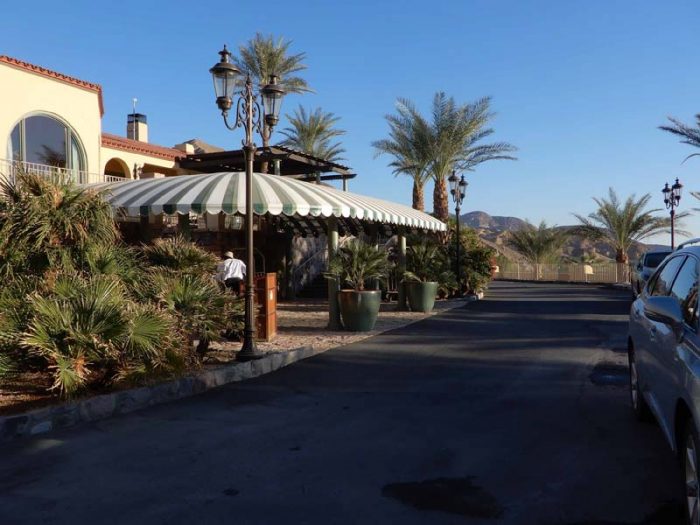
Furnace Creek Ranch
We had, admittedly, been putting off the Ranch and the Visitor Center. We knew, even in this Covid-era, they would be busy.
We began with the Ranch, knowing Herb had taken a number of photos at its entrance. Like this one, in 1948…
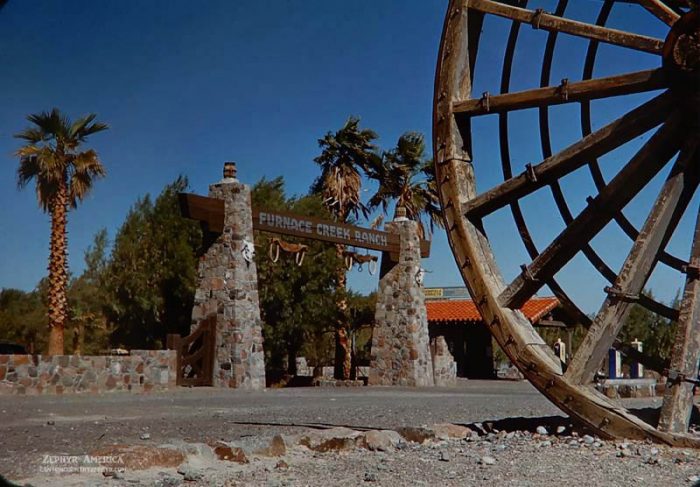
And this angle, during a 1959 bike rally…
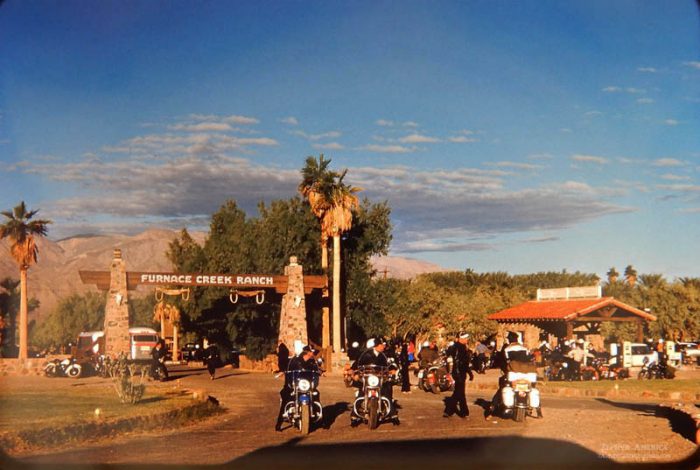
And this angle, in 1960…
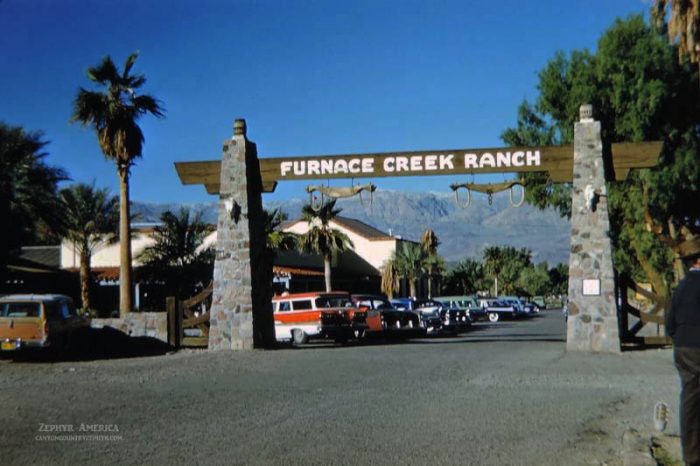
And despite the obvious expansions in amenities since Herb’s visits, the new landscaping and curbing, the entrance looks generally the same (even if the name has changed)…
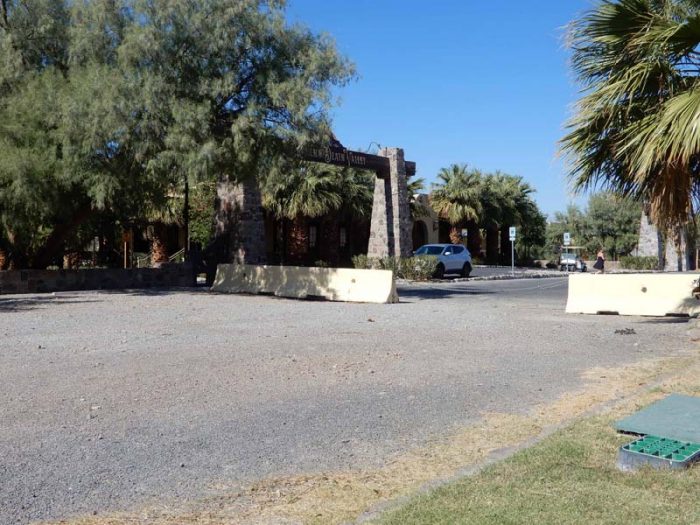
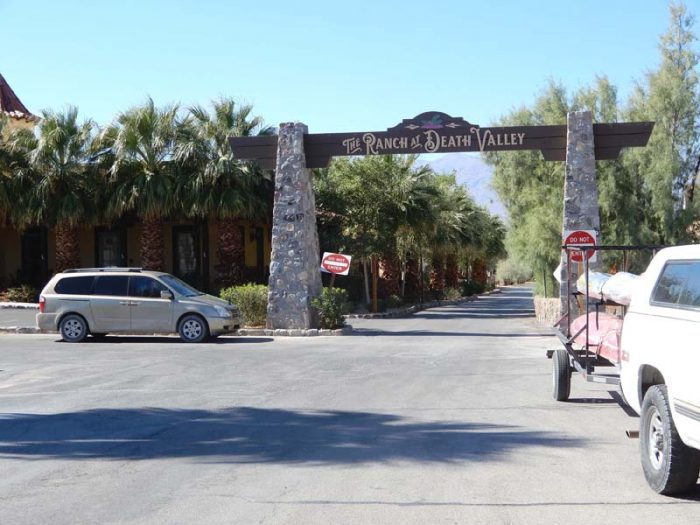
Not wanting to venture too close to the tourists dining outdoors at the ranch, we moved along to the Visitors Center. Herb took this shot of the newly-opened “Death Valley Museum” in 1961…
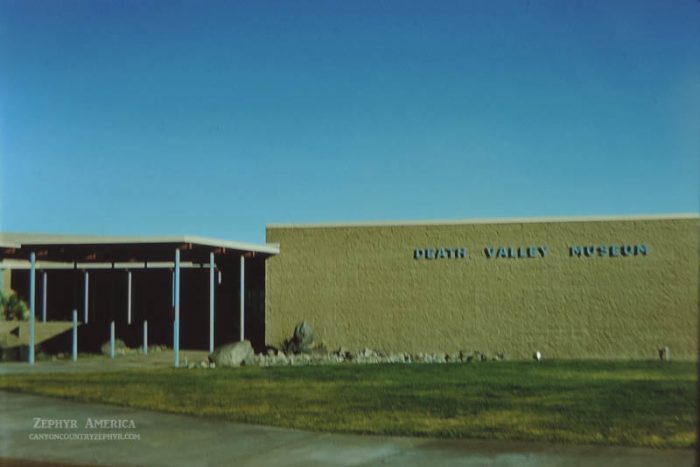
And, while the name has changed, it looks largely the same today…
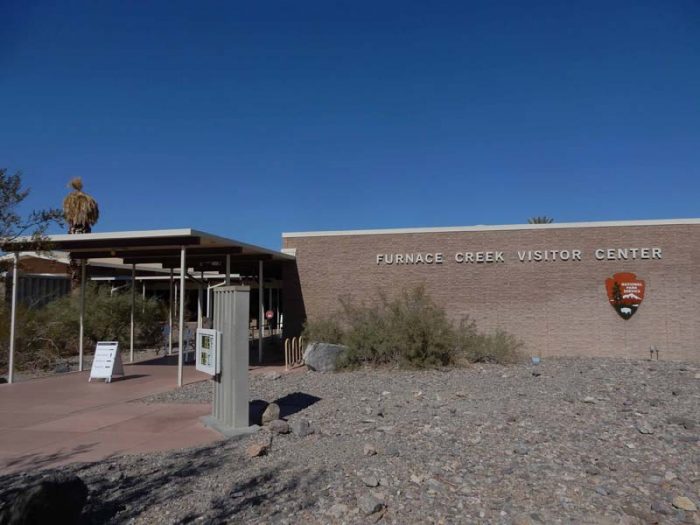
Herb and his parents wandered around to the courtyard in rear of the museum for this shot…
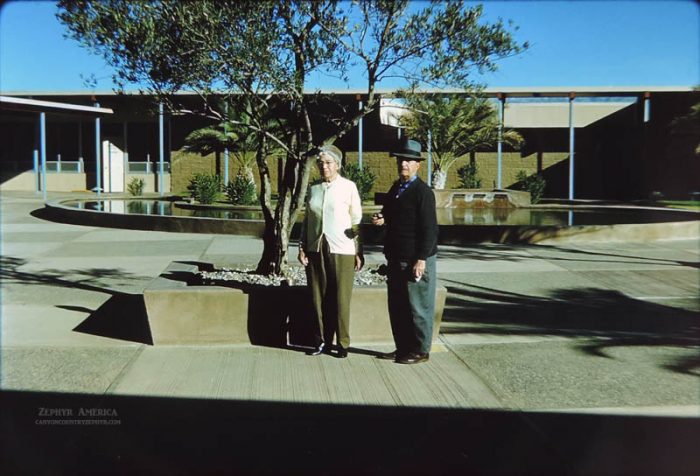
And we discovered that no one, in 2020, wanted to do the same. Despite the nearly full parking lot out front, we had the entire courtyard to ourselves. And while it would’ve been nice to see the area when there was still water in the reflecting pool, and not the blue pebbles the park service had substituted in its place, we didn’t mind the new bright-colored sails blocking the midday blast of sun…
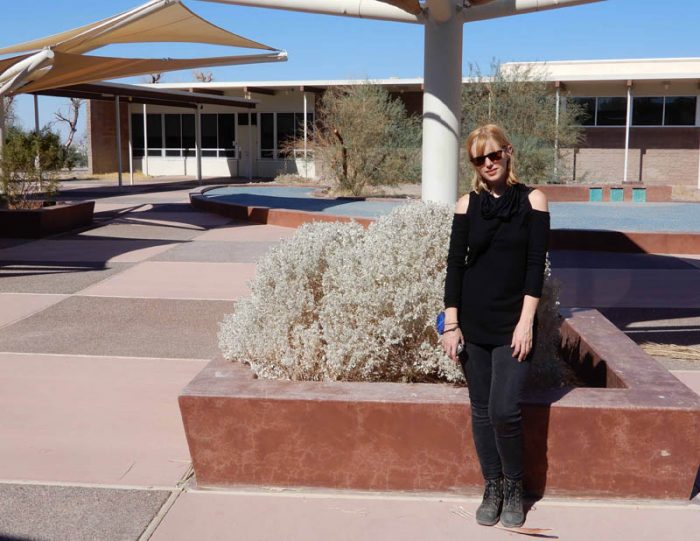
By this time, we were tired, hungry and a little over-sunned. We decided to retreat to the date palm orchards…
Which was when we realized there aren’t orchards at Furnace Creek anymore.
The date palms were described in Herb’s 1939 Guide:
FURNACE CREEK RANCH (L) (alt.-178) is irrigated by water piped from Furnace Creek. Bellerin V. Tex Bennett, the first man to live here, and probably the first white man to live in Death Valley, came here in 1870 with a few pairs of quail and the intention of growing alfalfa and barley. He left after a few years, when the Harmony Borax Works took over the ‘ranch.’ They grew acres of alfalfa to feed the mules, had a half-acre pond and a small orchard, and called the place Greenland. Its present name was given by the Pacific Coast Borax Company. Long rows of tamarisk were planted to break the hot desert winds, and Washingtonia palms, whose bunchy tops can today be seen for miles, were set out. Today (1938) there is a flourishing plantation of date palms, whose crop is boxed for sale (50¢ a pound); a grassy golf course occupies the former alfalfa field; and descendants of Bellerin Tex’s quail call to one another in the brush.”
In 1948, Joseph described stopping at the “date farm.” He wrote, “We spent a long time here watching the men get down the dates.” Bill Metzger, the family’s friend from Reno, “took movies” of the men working in the orchard.
Herb took this photo of the date palm orchard in 1960…
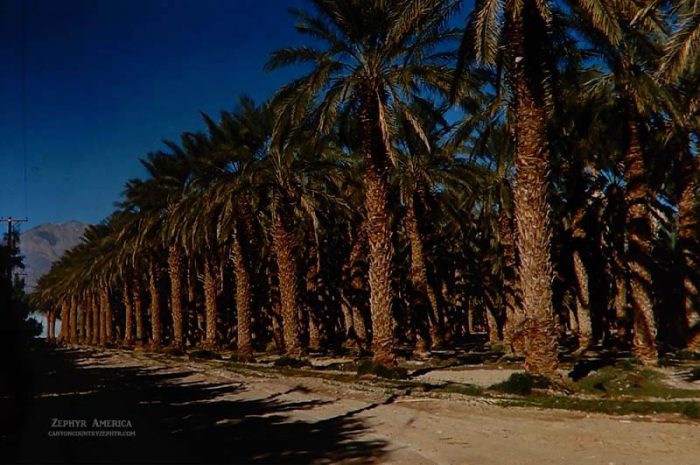
In 2020, no one would use the word “orchard” to describe what remains. One sparse row of date palms did little to mask the construction project underway…
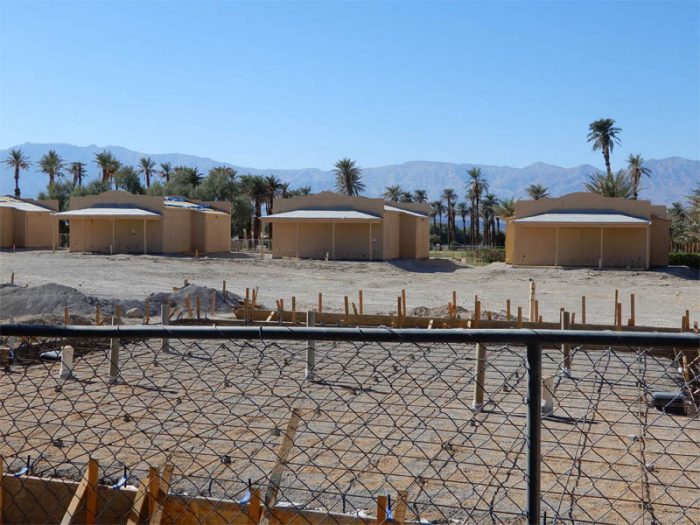
And while we’ve searched the internet and found multiple mentions of new construction at the Ranch, and even a mention of “the restoration of the date farm,” we haven’t yet found a good explanation for what has happened to the date palms that once flourished next to the road and now are clearly gone, or any description of what these wafer-board buildings are meant to be…
Badwater
After the disappointment at the orchard, we were braced for more bad news. We drove down the road to the “Devils Golf Course,” looking for the site of one of Herb’s most beautiful 1946 photos, but the mountains never lined up for us, and we left that spot feeling stumped. We moved along the road to Badwater.
Herb took a photo of the spot—the lowest point in the western hemisphere—in 1948. According the WPA guide, a notation had already been left in the rock face across from the salty pool to show the elevation of sea level. But there was little fanfare to the place in those days. It was just a wide spot in the road…
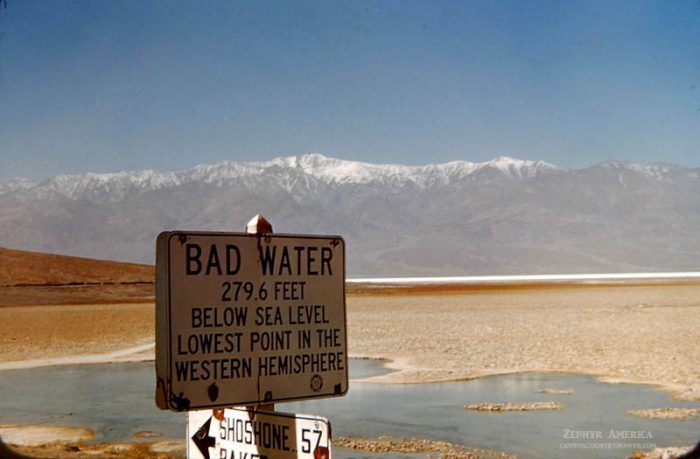
In 2020, however, the mark of the Park Service’s “improvements” were everywhere. Vast stretches of concrete. An enormous parking lot. Sidewalks and fencing and toilets. Yes, this looked like contemporary America. We were both feeling pretty cynical by this point. What would Herb have made of all this? He was such a kindhearted man, he probably would have chosen to stay politely silent. We watched the string of people walking up and down the trail and grumbled to each other about Instagram and “progress” in the National Parks.
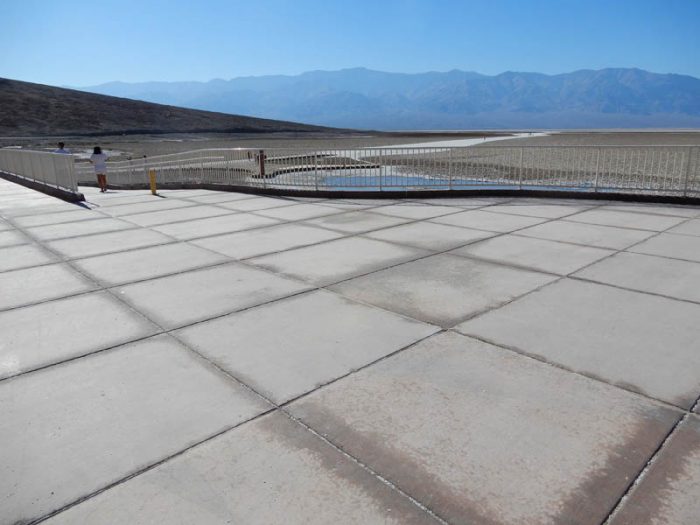
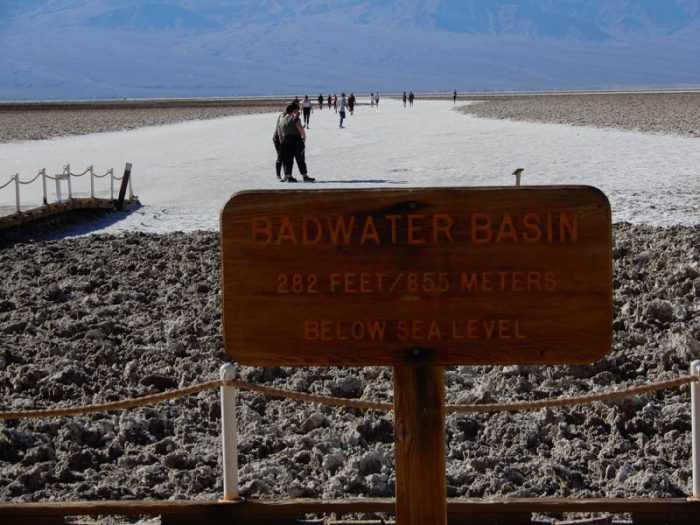
We took the shots we needed. Jim said, “Let’s get out of here,” and I immediately agreed. We maneuvered around the towering RV’s to find our way back onto the road.
The Devil’s Golf Course
As we drove back toward the intersection of the Badwater Road and the main highway, we were both still wondering about that “Devil’s Golf Course” shot. We could see how the mountains in the distance were almost, but not quite, lined up for it. It’s the main frustration of orienting photographs. You stare at them, then look up, then stare at the photo, then up again. And somehow you need for those mountains to move behind those mountains. So you start looking around.
We could tell that the angle of the shot was facing somehow catty-corner to us, in a way that the Devil’s Golf Course road never faced. I stared down at the map, and turned it one way and another, and as we passed the turn for the official Devil’s Golf Course “spot”, I said, “Take the next left.” Jim looked skeptical, and I agreed that it was a long shot. We’d already decided that Herb’s road had to be gone, or else changed drastically with time. But, still, it was one of Herb’s most beautiful shots of the Valley. We had to try everything.
We turned down the West Side Road. We rumbled along the gravel, still unsure. After a while, the road made a sharp turn. Jim looked in the rearview mirror. “Wait,” he said suddenly, under his breath. I looked into my side mirror, and began to see the mountains aligning themselves. “Right…” he said, driving another few feet. He paused, then another few feet. “There,” he said finally. We both piled out of the car. We stared behind us and laughed. We found it.
Herb stopped to show off his brand new Ford Super Deluxe in this spot in 1946…
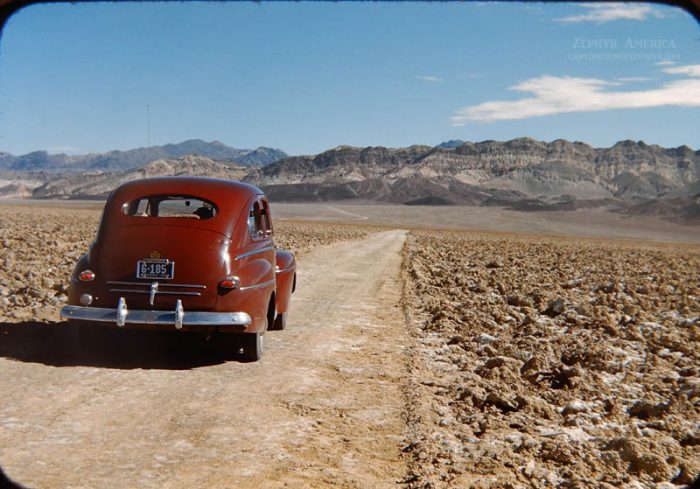
And 74 years later, we stood where he had.
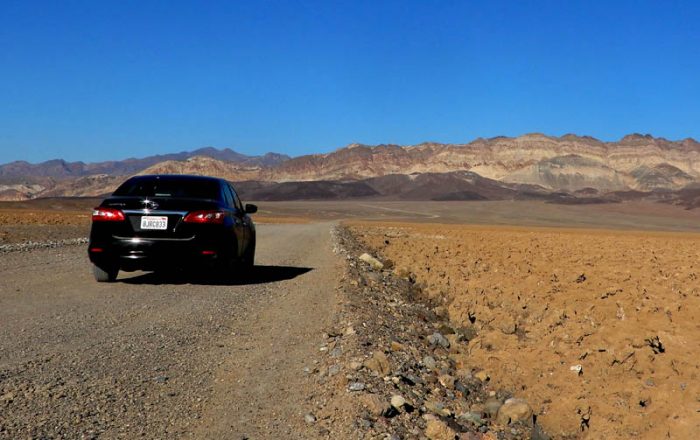
Rifling through our collection of Herb’s photos, I pulled out another that we knew was somewhere nearby. Herb on the salt crystals. We looked at it for a moment, and then realized the alignment was the same. It was almost certainly taken the same day, at the same time…
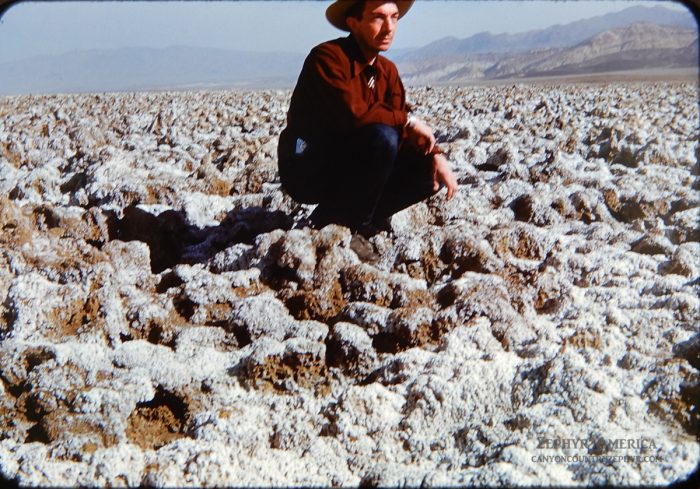
Jim Stiles in 2020.
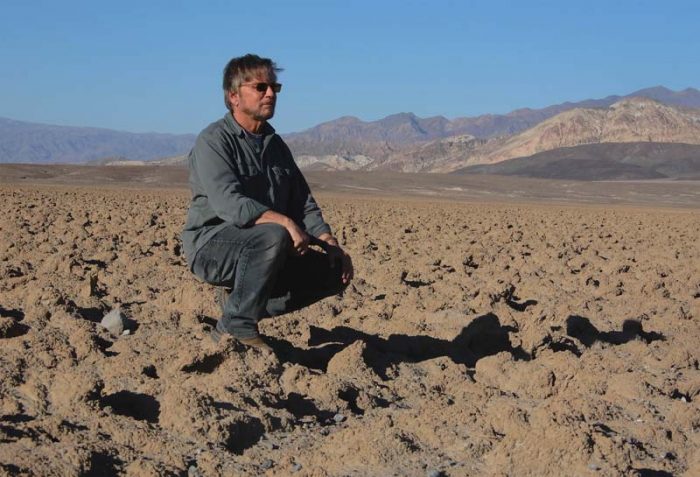
Now we were feeling good again. We took a moment, out in the salt, to just breathe in the Death Valley air and talk about how nowhere, and I mean no place on earth, was like this spot. No wonder Herb escaped out here so often during the cold Reno winters. What a place to stand, and feel like time didn’t exist.
As Herb’s WPA Guide put it:
In a world of constant change, where cities rise swiftly in wild places, where green forests turn overnight to ash heaps or black scars, where fertile prairies become shifting dust, Death Valley changes little from decade to decade; its desert plants seem no fewer, no more, and little vagrant winds continue to carry the same faint, dry odor of earth and rock, and to sing the same soft, tuneless songs. Everything in the Valley seems constant but the color; it varies with the changing light, ranging through an infinite variety of tones, from the bleached, exhausted ones seen under the blazing summer sun to the rich hues that glow in splendor under the low gray sky of a winter day.
** ** **
Now that the day had redeemed itself—and we had redeemed ourselves as researchers—the drive out the rest of the Badwater road was a pleasure. The sun was beginning to set along the Panamints, and the light stretched sideways across the valley. We stopped once, spotting a memorable Mushroom Rock from another of Herb’s photos. Here’s Herb’s photo, from 1947…
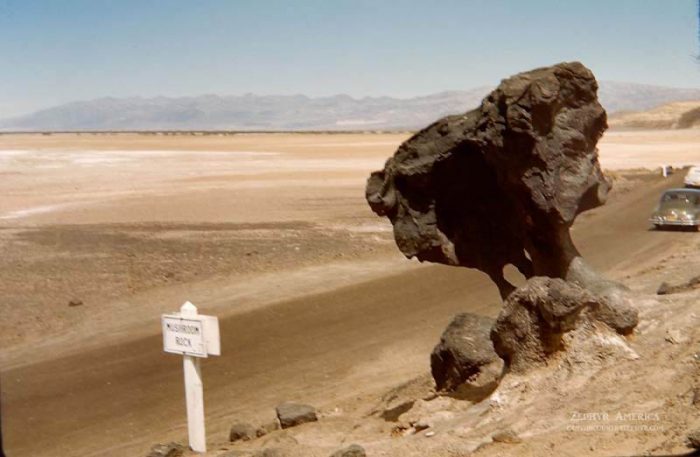
And the rock today (looking weather-beaten and worn down by time)…
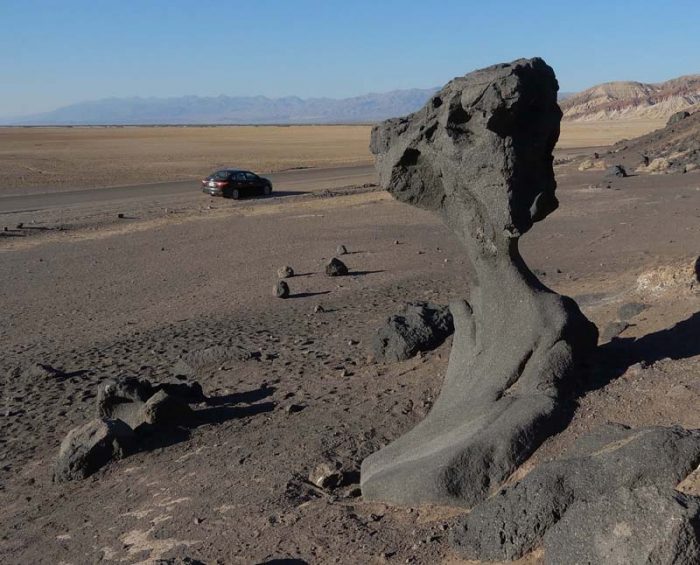
We breezed past Furnace Creek, and took the cut off for Daylight Pass. As we ascended the eastern slope of the Valley, we stopped and pulled to the side of the road. We looked back and watched the warm evening light withdrawing across the salt beds.
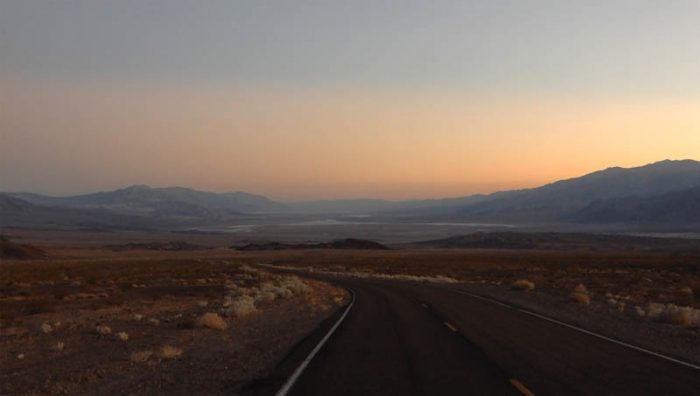
Still on Herb’s trail—now his homeward trail. We made our way toward Beatty.
Jim Stiles is Publisher of the Canyon Country Zephyr.
To comment, scroll to the bottom of the page.
Don’t forget the Zephyr ads! All links are hot!




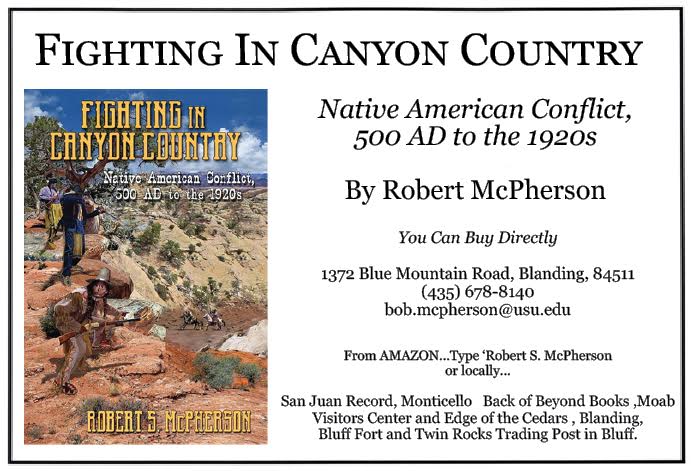

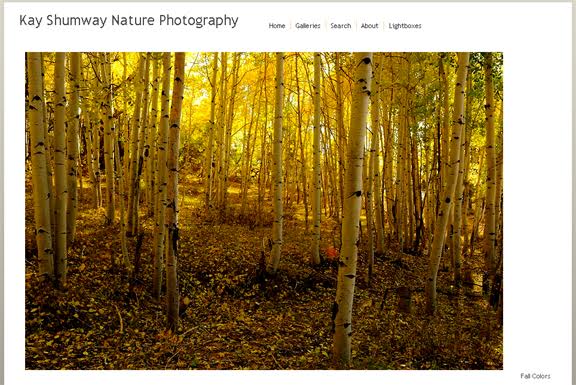
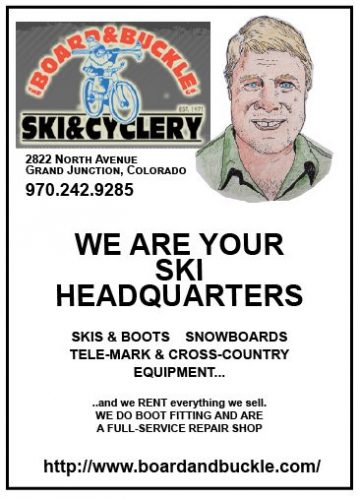

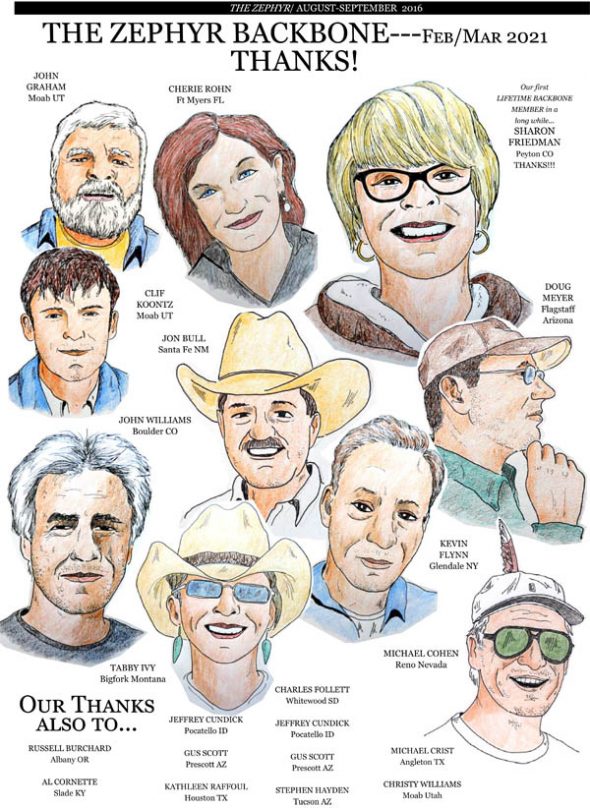
Oh my word!!! What wonderful photos of then and now,,I was totally mesmerized by them..You two have done a fantastic job of preserving Herbs memories..Thank you so so very much
I worked three seasons as an interpreter at Furnace Creek/Death Valley Visitor Center in the early 80’s. Coming as I did from the Northern Rockies, I couldn’t at first credit that these ash heaps of mountains (as I first thought of them) actually merited a place in the NPS. I loved those same mountains and valleys within a month or two. In particular, I think alluvial fans are an underappreciated, beautiful feature of the landscape. And I learned with particular force the worth of water. The date palm grove was still there, and it was incredibly romantic to walk through it on a warm, moonlight spring night. Much beauty, thank you for the memories.
Have always enjoyed stories about herb. Thank you
Thank you so much for this wonderful article and taking the trip to follow and photo Herb’s trips to Death Valley. I am Herb’s great niece, and remember all the times he (and Aunt Sadie) would return to my grandparents’ home in Ringoes, New Jersey. My mother was his first cousin and our family would all arrive, have dinner with Herb and our relatives, and await his “travelogue.” It was always a momentous evening. Herb would set up his projector and screen and spend about two hours delighting us with his photos of the West, along with great narrative.
Thanks Marie…we’d love to hear more from you about your memories of Herb.
Wow — great photo-journey. It makes me realize I’ve neglected some of the other Herb Ringer stories, so I will check them out. I understand he also did some “photojourneying” up here in western Canada. Any idea where? (If he came to Vancouver Island, I’d love to peruse some of his pics.)
What a well-done labor of love – matching up photos from the 1940s/60s with the Death Valley of today. This would make for an excellent photo exhibit at the Death Valley Museum.
I share your negative reactions to the crowds at Death Valley which I’m afraid detract from the atmosphere at most national parks these days. They are being loved to death. I’ve been to Death Valley twice. The first time in Christmas 1991, I recall few crowds. Twenty years later, my partner Judy and I, felt overwhelmed by the crowds at Bad Water and many of the hiking trails.
I’m pretty good at identifying 1950s cars and have a couple comments:
– The fourth Texas Creek photo with all the cars and trailers was probably taken no earlier than late 1958. The red car on the left appears to be a 1959 Chevy station wagon (the fins are the clue).
– The second Furnace Creek photo could not have been taken in 1948. That’s a 1951 Buick Roadmaster convertible parked in front of the inn.
– By the way, those Ford “woody” station wagons in a couple of the photos are very cool!